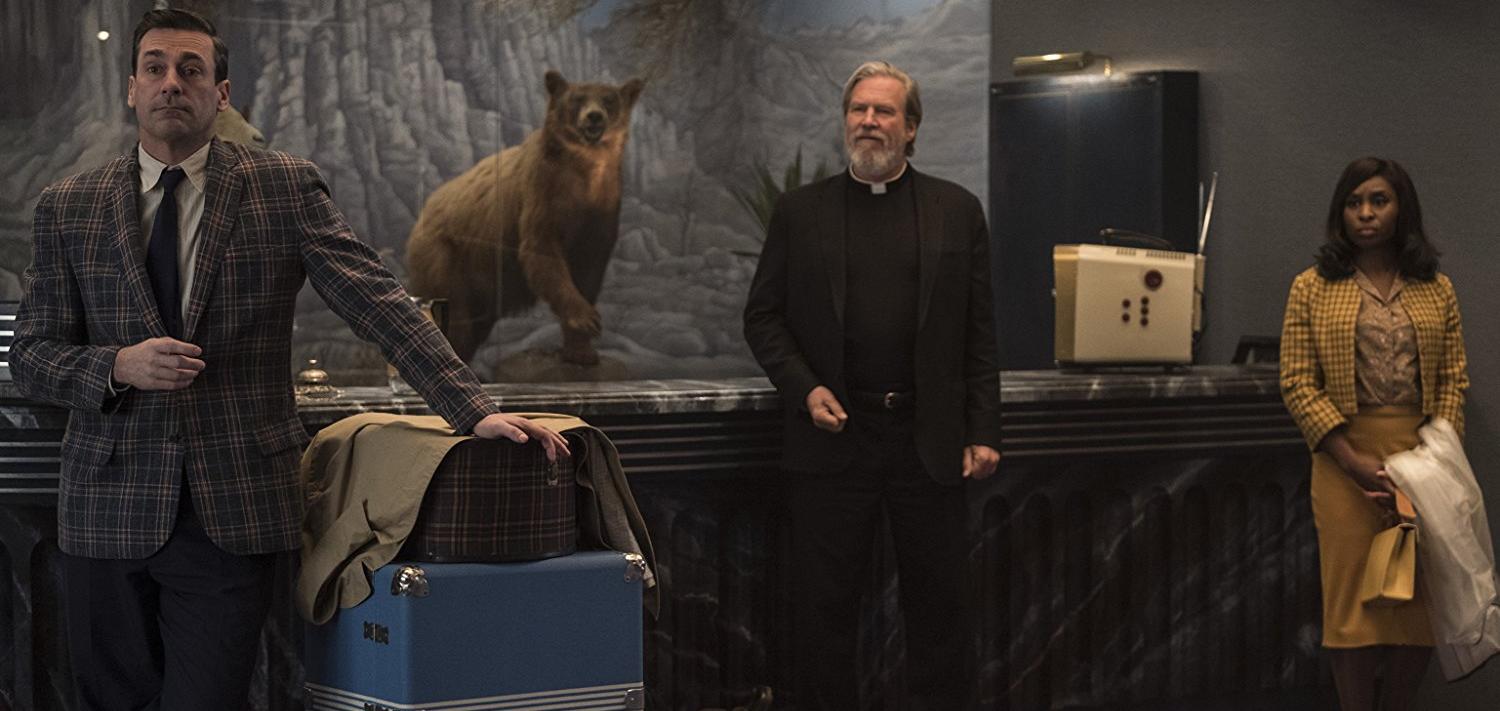Looking for God in All the Wrong Places, by Bob Connally
15 Oct
Bad Times at the El Royale is a difficult film to review because everything we think we know at the start is revealed to be a lie before we’ve even had a chance to settle in. This is cleverly designed by writer-director Drew Goddard (The Cabin in the Woods) and is ultimately one of the movie’s two central themes. The other is about the various ways its characters relate to God.
After a 1959 prologue that includes burying a suitcase in the floor of a hotel room and a man being shot to death, Goddard introduces us to Catholic priest Daniel Flynn (Jeff Bridges) and a twenty-something named Darlene (Tony Award winner Cynthia Erivo) ten years later. Each is arriving at the El Royale, a hotel on the California-Nevada border. Already inside, waiting impatiently for a clerk to check him in is southern vacuum salesman Laramie Seymour Sullivan (Jon Hamm). The three awkwardly try to converse as they continue to wait for someone to appear at the El Royale’s front desk. When help finally arrives it’s in the form of a visibly worried young man named Miles (Lewis Pullman) who upon seeing Father Flynn unabashedly tells him, “The El Royale is no place for a priest.” Flynn responds, “Then this is exactly where the Lord wants me to be.” This proves to be one of many examples where the true meaning of the dialogue only fully reveals itself later on. The final guest to check in is hippie Emily Summerspring (Dakota Johnson), who is in no mood to talk to anyone.
Once Goddard has put his pieces into place he immediately begins to show us that no one at the El Royale is who he or she appears to be. These are not simply twists for their own sake however. Each character makes assumptions about the others based on what they are presented with, all while hiding behind their own lies large and small. Everyone there believes he or she is the only one with a secret. One guest discovers early on though that the hotel itself has secrets of its own and that there are literal windows into everyone else’s.
While Bad Times presents itself as a stylized ensemble thriller, the film is much like its characters and its titular hotel. Goddard uses the genre as a way to tell a story about how assumptions can have disastrous results and about the different ways people can view God. More to the point, what each person sees as his or her biggest individual need from God. No one would mistake Bad Times at the El Royale for a Christian film, but as is so often the case, these themes are explored in a far more interesting and thought-provoking way than they almost certainly ever would be in a Christian film.
Goddard breaks up his film into pieces, often overlapping with different perspectives and with more information than we’d had before. Throughout though, we see one character looking to God for guidance, while another seeks forgiveness, and another still uses God simply as a means to deflect attention. Meanwhile, another is trying to help a loved one escape from a cult leader presenting himself as God on earth (Chris Hemsworth). While the guests and bellboy at the El Royale seek God for their own reasons, the California cult leader is seeking what he believes to be his in the same place.
Of all of these, it’s the character with the need for forgiveness who seems the most desperate and who has the greatest sense that the need is urgent. On one level it makes sense why this character feels this way, given how much each person at the El Royale knows about what is really happening there. Still, there’s much more to this character or this need than we initially can realize. In a way, it makes this character very relatable but it’s also a good lesson in having empathy for others seeking redemption for wrongs they’ve committed that we may not fully understand.
In terms of pacing, Bad Times does not move along at the clip one might expect. While it’s not a slow-moving film, it takes its time and regularly jumps to flashbacks that break up momentum. This seems to be a conscious decision on Goddard’s part so there’s no sense that the film is getting away from him. The movie does pretty much feel its 2 hour and 21 minute running time though, which is not necessarily a bad thing but it’s something some viewers might want to keep in mind.
As noted above, Goddard’s script is full of exchanges and lines that have deeper or entirely different meanings than they appear to have on the surface. By the movie’s third act we’re able to find the truths buried in lies and vice versa. This is made all the more effective by the performances, particularly by Bridges, Erivo, and Pullman. Hemsworth’s role is much smaller but he owns the screen every moment he’s on it, with one notable exception in which Darlene completely dresses his cult leader down much to the audience’s satisfaction.
Placing a group of characters into a dangerous situation in a confined space has practically become its own subgenre, going back decades. Key Largo, Bad Day at Black Rock, Alien, Dawn of the Dead, The Thing, and The Hateful Eight are just a few films to use this device to tell unique stories. Any number of say, “cabin in the woods”-style horror movies do the same. Only time will tell how well Bad Times at the El Royale stacks up amongst movies such as those, but it is definitely a worthy addition to the subgenre thanks to some excellent performances and an intelligent exploration of strong themes.




No comments yet